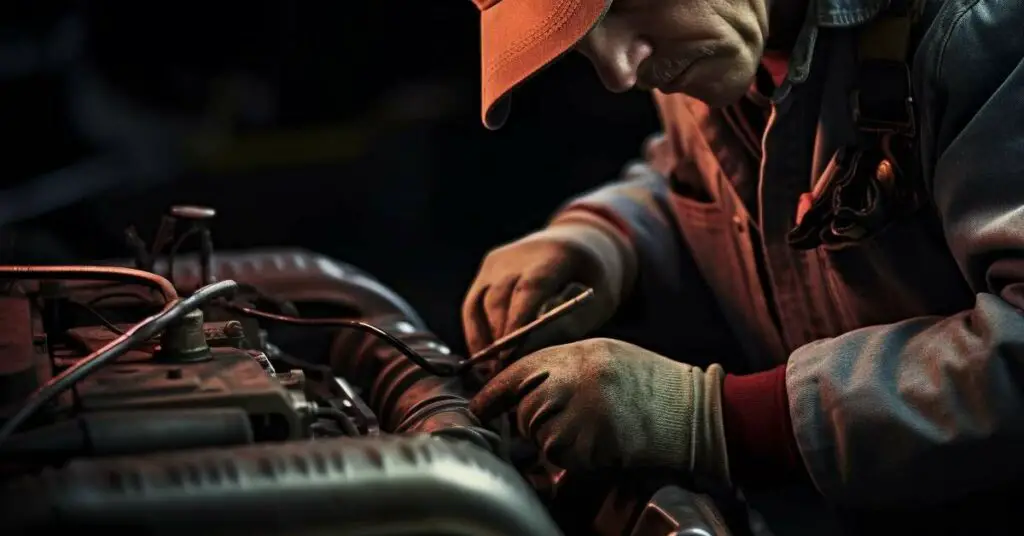
Every so often, our beloved four-wheeled companions emit sounds that can range from the musical hum of the engine to the less appreciated screeches and whistles. A common concern among drivers is the mysterious whistling sound that seems to have a knack for evoking worry. While it might send a shiver down your spine, the good news is that this whistling symphony is often indicative of manageable issues. However, turning a deaf ear to these automotive cries for attention can sometimes lead to more severe problems down the line. Hence, identifying the source of this whistling can be the first step to nipping potential serious car troubles in the bud. This piece aims to delve into the various reasons behind the whistling sound your car might be making, shedding light on the mystery, and guiding you on how to address it. So, let’s tune into this automotive melody and decode the notes of concern.
Key Takeaways
- Serpentine Belt: A loose or damaged serpentine belt is a common cause of whistling, especially during the start of the engine or sharp turns.
- Vacuum or Turbo Intercooler Leak: Vacuum leaks, noticeable during acceleration, and turbo intercooler leaks in turbocharged vehicles can cause a whistling sound.
- Hydraulic Power Steering System: Low fluid levels or a failing pump can create a whistling sound, particularly noticeable when turning the steering wheel.
- Air Conditioner Issues: Loose or damaged ducts and hoses, or blockages in the AC system can cause a whistling sound emanating from the air vents.
- Radiator Pressure Cap Damage: A damaged radiator pressure cap can lead to a whistling sound due to pressure imbalances in the cooling system.
- Exhaust System Issues: Cracks, holes, or loose connections in the exhaust piping can create a whistling sound, particularly during acceleration or when the engine is under load.
- Weather Stripping Damage: Damaged weather stripping around doors and windows can allow air to whistle through as you drive, especially at higher speeds.
Serpentine or Drive Belt
The serpentine belt, also known as the drive belt, is like the energetic conductor of the automotive orchestra, directing various parts such as the alternator, power steering pump, water pump, and air conditioner compressor. It’s a long, winding belt that keeps these crucial components in sync and your car running smoothly. However, when this maestro loses its beat, you might start to hear a whistling tune.
A common culprit behind the whistling sound is a faulty or loose serpentine belt. This can happen due to normal wear and tear, improper tension, or even the presence of foreign substances. For instance, if your serpentine belt has become glazed or slick due to oil or coolant leaks, it may slip on the pulleys, creating a high-pitched whistle as it spins. Similarly, a worn-out or stretched belt may not sit properly on the pulleys, leading to a whistling sound, especially when you start the engine or during sharp turns.
One particular scenario where the serpentine belt may chant its whistling tune is when there’s moisture on the belt. This is common in rainy weather or after driving through a puddle. The moisture causes the belt to slip momentarily, creating a short-lived whistling sound that usually goes away once the belt dries out.
Addressing a whistling serpentine belt may involve tightening the belt, cleaning it, or in cases where it’s worn out or damaged, replacing it. It’s a straightforward fix that can bring back the harmonious hum of your engine, replacing the eerie whistle with the sweet sound of automotive synergy. So, the next time your car starts whistling, it might just be the serpentine belt calling out for a little tune-up.
Vacuum or Turbo Intercooler Leak
Under the hood of your car lies a complex network of hoses and connections forming the vacuum system. This system is akin to the lungs of your vehicle, controlling the airflow between the mass airflow sensor and the engine. It’s essential for various operations, such as providing power to the brake booster and aiding in the efficient combustion of fuel. When everything is sealed tight, the system operates silently, but when there’s a leak, the escape of air produces a characteristic whistling sound that amplifies during acceleration.
A vacuum leak occurs when the vacuum hoses get damaged or come loose, allowing air to escape. The source of the whistle is the air getting sucked through these small openings, akin to how you’d whistle through puckered lips. The sound is more noticeable during acceleration as the demand for airflow increases, making the whistle louder and more pronounced.
In turbocharged vehicles, the turbo intercooler system operates under similar principles. It’s responsible for cooling the hot air generated by the turbo before it enters the engine to improve performance and efficiency. However, a leak in the intercooler or its connecting hoses can also result in a whistling sound, particularly when the turbo is spooling up. The high-pressure air escaping through the tiny leaks creates a whistling tune that rings through the engine bay.
Identifying and fixing a vacuum or turbo intercooler leak early on is crucial. A vacuum leak, besides being noisy, can lead to poor engine performance, increased fuel consumption, and potentially damaging lean running conditions. Similarly, an intercooler leak can reduce your turbo system’s efficiency, robbing your car of performance and fuel economy.
Hydraulic Power Steering System
Steering your car should feel like a waltz – smooth, effortless, and in rhythm with the road. However, when the hydraulic power steering system hits a snag, this dance can quickly turn into a wrestling match accompanied by a whistling soundtrack.
The hydraulic power steering system operates on a fluid mechanism to make steering your car a breeze. It requires a special fluid to maintain the hydraulic pressure necessary for easy steering. When this fluid is low, or the pump is on the brink of failure, a whistling sound might emerge as your car’s way of crying out for help. This whistle often gets louder and more noticeable the more you turn the steering wheel, making it a clear sign of power steering woes.
The reasons for the whistling could range from a simple low fluid level to more serious issues like a failing power steering pump or leaks in the system. Low fluid levels are often an easy fix – topping off the power steering fluid can silence the whistle and restore the smooth steering you’re accustomed to. However, if the problem lies in the pump or other components, the repair could be more complex and potentially costly. Yet, addressing these issues promptly can prevent further damage and ensure that your drive remains a graceful dance rather than a tussle.
Power steering problems can escalate, making steering laborious and potentially hazardous. Hence, if the whistle in your car intensifies as you wrestle with the steering wheel, it’s a call to action. Checking the power steering fluid and system should be a priority to ensure your safety on the road and to keep the steering dance smooth and melodious, free from the discord of a whistling tune.
Air Conditioner Issues
The air conditioner (AC) in your car does more than just keep you cool during the summer heat; it creates a comfortable and pleasant driving environment. However, when the AC system encounters issues, it can transition from a silent provider of cool breeze to a whistling annoyance.
The whistling sound associated with air conditioner issues often emanates from the car air vents. This could be due to a variety of factors. The AC system operates with a network of ducts and hoses that channel air throughout your vehicle. When there’s a disconnect, or if these ducts or hoses get damaged or loose, they may create a whistling sound as the air rushes through the irregular or narrowed passages.
Moreover, the whistling sound could also be a sign of blockages within the ductwork or debris caught in the blower motor. In some cases, it might just be a matter of a cabin filter clogged with dirt and debris, restricting the airflow and creating a whistle as the air tries to pass through.
Addressing the whistling sound from your car’s air conditioner might involve a thorough inspection of the AC system. Simple solutions could range from replacing a clogged cabin filter to re-securing loose ductwork. However, if the issue lies deeper, such as a malfunctioning blower motor or significant blockages within the ducts, you might need the expertise of a professional to restore the quiet and comfort to your cabin.
Radiator Pressure Cap Damage
The radiator is your car’s cooling maestro, orchestrating the flow of coolant to keep the engine temperature in check. Central to this cooling ensemble is the radiator pressure cap, a small yet pivotal component that maintains the optimal pressure within the cooling system. However, when this cap gets damaged or defective, it could lead to a whistling sound that reverberates under the hood.
A damaged radiator pressure cap can fail to hold the pressure within the cooling system, allowing coolant to escape, and air to enter. When the pressure in the cooling system drops, the boiling point of the coolant lowers, potentially leading to overheating issues. The whistling sound is often a result of the air escaping through the compromised cap or other openings that have developed due to the pressure imbalance.
The whistling tune of a defective radiator pressure cap is not one to ignore. It’s a red flag that there could be pressure issues within the cooling system, which, if left unaddressed, could lead to overheating and significant engine damage. The remedy could be as simple as replacing the faulty cap, a small investment that can save you from costly repairs and ensure that the cooling system continues to perform its temperature-taming magic efficiently.
Exhaust System Issues
Your car’s exhaust system is like the seasoned bass player in a band, humming a low tune that resonates with the rhythm of your drive. But when issues arise in this system, the tune can escalate to a high-pitched whistle, signaling that something’s amiss.
The exhaust system is designed to channel exhaust gases safely out of your car, reducing emissions, improving fuel efficiency, and keeping engine noise to a minimum. A well-sealed exhaust system should operate relatively quietly. However, cracks, holes, or loose connections in the exhaust piping can cause a whistling sound as the exhaust gases escape through these unintended openings1.
The whistle is often more pronounced during acceleration or when the engine is under load, as the volume of exhaust gases increases. The escaping gases not only create an annoying whistling sound but can also lead to performance issues, increased emissions, and even potential health hazards if exhaust gases enter the cabin.
Fixing exhaust system issues might involve patching up small holes or cracks, tightening loose connections, or in more severe cases, replacing damaged sections of the exhaust piping. It’s a task that might require a professional’s touch due to the high temperatures and hazardous materials involved.
Weather Stripping Damage
Imagine driving down the highway with a cool breeze gently tousling your hair, the world rushing by in a blur. Now, add a high-pitched whistle to this picture, cutting through the serenity of your drive. The culprit could very well be the weather stripping around your car’s doors and windows.
Weather stripping is the unsung hero that seals your car’s doors and windows, keeping out the elements and maintaining a comfortable, quiet cabin. However, over time, this stripping can wear out or get damaged, losing its effectiveness. When this happens, air can whistle through the gaps as you cruise down the road, creating an annoying soundtrack to your journey1.
The whistle can get particularly loud on highways or in windy conditions, as the speed increases the force with which the air rushes through the gaps. Besides the noise, damaged weather stripping can also let in water, dust, and other undesirables, making your driving experience less than pleasant.
Fixing weather stripping issues can range from simple DIY fixes like re-securing loose strips or applying adhesive sealant, to replacing the damaged stripping altogether. It’s a relatively straightforward fix, but one that can significantly enhance the comfort and quiet of your cabin.
Conclusion
The open road, the hum of the engine, and the freedom to explore – driving is a joy that often comes with its own soundtrack. However, when a whistling sound cuts through the melody of your journey, it’s a sign that your car is voicing a concern. From the serpentine belt’s rhythm to the silent operation of the air conditioner, every part plays a note in the symphony of your vehicle’s operation. When one instrument falls out of tune, the harmony is disrupted, calling for your attention.
Timely identification and rectification of these issues not only spare you from a dissonant drive but also prevent minor issues from escalating into major, costly repairs. So, the next time your car whistles a tune, take a moment to listen, investigate, and set the rhythm right. Your car, and your wallet, will thank you.

As a seasoned mechanic and proud owner of three successful car workshops, I’ve dedicated my life to helping people just like you overcome their everyday automotive challenges. I created this website as a labor of love, with a simple mission: to make car maintenance and repairs more accessible and approachable for the “average joe.”
